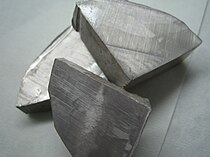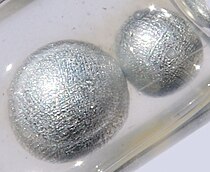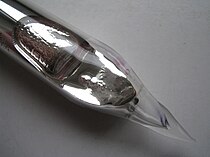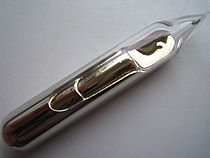| Alkali metals | |||||||||||
|---|---|---|---|---|---|---|---|---|---|---|---|
| |||||||||||
| ↓ Period | |||||||||||
| 2 | Lithium (Li) 3 | ||||||||||
| 3 | Sodium (Na) 11 | ||||||||||
| 4 | Potassium (K) 19 | ||||||||||
| 5 | Rubidium (Rb) 37 | ||||||||||
| 6 | Caesium (Cs) 55 | ||||||||||
| 7 | Francium (Fr) 87 | ||||||||||
|
Legend
| |||||||||||
The alkali metals consist of the chemical elements lithium (Li), sodium (Na), potassium (K),[note 1] rubidium (Rb), caesium (Cs),[note 2] and francium (Fr). Together with hydrogen they constitute group 1,[note 3] which lies in the s-block of the periodic table. All alkali metals have their outermost electron in an s-orbital: this shared electron configuration results in their having very similar characteristic properties.[note 4] Indeed, the alkali metals provide the best example of group trends in properties in the periodic table, with elements exhibiting well-characterised homologous behaviour.[5] This family of elements is also known as the lithium family after its leading element.
The alkali metals are all shiny, soft, highly reactive metals at standard temperature and pressure and readily lose their outermost electron to form cations with charge +1. They can all be cut easily with a knife due to their softness, exposing a shiny surface that tarnishes rapidly in air due to oxidation by atmospheric moisture and oxygen (and in the case of lithium, nitrogen). Because of their high reactivity, they must be stored under oil to prevent reaction with air, and are found naturally only in salts and never as the free elements. Caesium, the fifth alkali metal, is the most reactive of all the metals. All the alkali metals react with water, with the heavier alkali metals reacting more vigorously than the lighter ones.
All of the discovered alkali metals occur in nature as their compounds: in order of abundance, sodium is the most abundant, followed by potassium, lithium, rubidium, caesium, and finally francium, which is very rare due to its extremely high radioactivity; francium occurs only in minute traces in nature as an intermediate step in some obscure side branches of the natural decay chains. Experiments have been conducted to attempt the synthesis of element 119, which is likely to be the next member of the group; none were successful. However, ununennium may not be an alkali metal due to relativistic effects, which are predicted to have a large influence on the chemical properties of superheavy elements; even if it does turn out to be an alkali metal, it is predicted to have some differences in physical and chemical properties from its lighter homologues.
Most alkali metals have many different applications. One of the best-known applications of the pure elements is the use of rubidium and caesium in atomic clocks, of which caesium atomic clocks form the basis of the second. A common application of the compounds of sodium is the sodium-vapour lamp, which emits light very efficiently. Table salt, or sodium chloride, has been used since antiquity. Lithium finds use as a psychiatric medication and as an anode in lithium batteries. Sodium, potassium and possibly lithium are essential elements, having major biological roles as electrolytes, and although the other alkali metals are not essential, they also have various effects on the body, both beneficial and harmful.
Cite error: There are <ref group=note> tags on this page, but the references will not show without a {{reflist|group=note}} template (see the help page).
- ^ International Union of Pure and Applied Chemistry (2005). Nomenclature of Inorganic Chemistry (IUPAC Recommendations 2005). Cambridge (UK): RSC–IUPAC. ISBN 0-85404-438-8. pp. 248–49. Electronic version..
- ^ Coghill, Anne M.; Garson, Lorrin R., eds. (2006). The ACS Style Guide: Effective Communication of Scientific Information (3rd ed.). Washington, D.C.: American Chemical Society. p. 127. ISBN 978-0-8412-3999-9.
- ^ Coplen, T. B.; Peiser, H. S. (1998). "History of the recommended atomic-weight values from 1882 to 1997: a comparison of differences from current values to the estimated uncertainties of earlier values" (PDF). Pure Appl. Chem. 70 (1): 237–257. doi:10.1351/pac199870010237. S2CID 96729044. Archived (PDF) from the original on 9 October 2022.
- ^ Fluck, E. (1988). "New Notations in the Periodic Table" (PDF). Pure Appl. Chem. 60 (3). IUPAC: 431–436. doi:10.1351/pac198860030431. S2CID 96704008. Archived (PDF) from the original on 9 October 2022. Retrieved 24 March 2012.
- ^ Royal Society of Chemistry. "Visual Elements: Group 1 – The Alkali Metals". Visual Elements. Royal Society of Chemistry. Archived from the original on 5 August 2012. Retrieved 13 January 2012.




